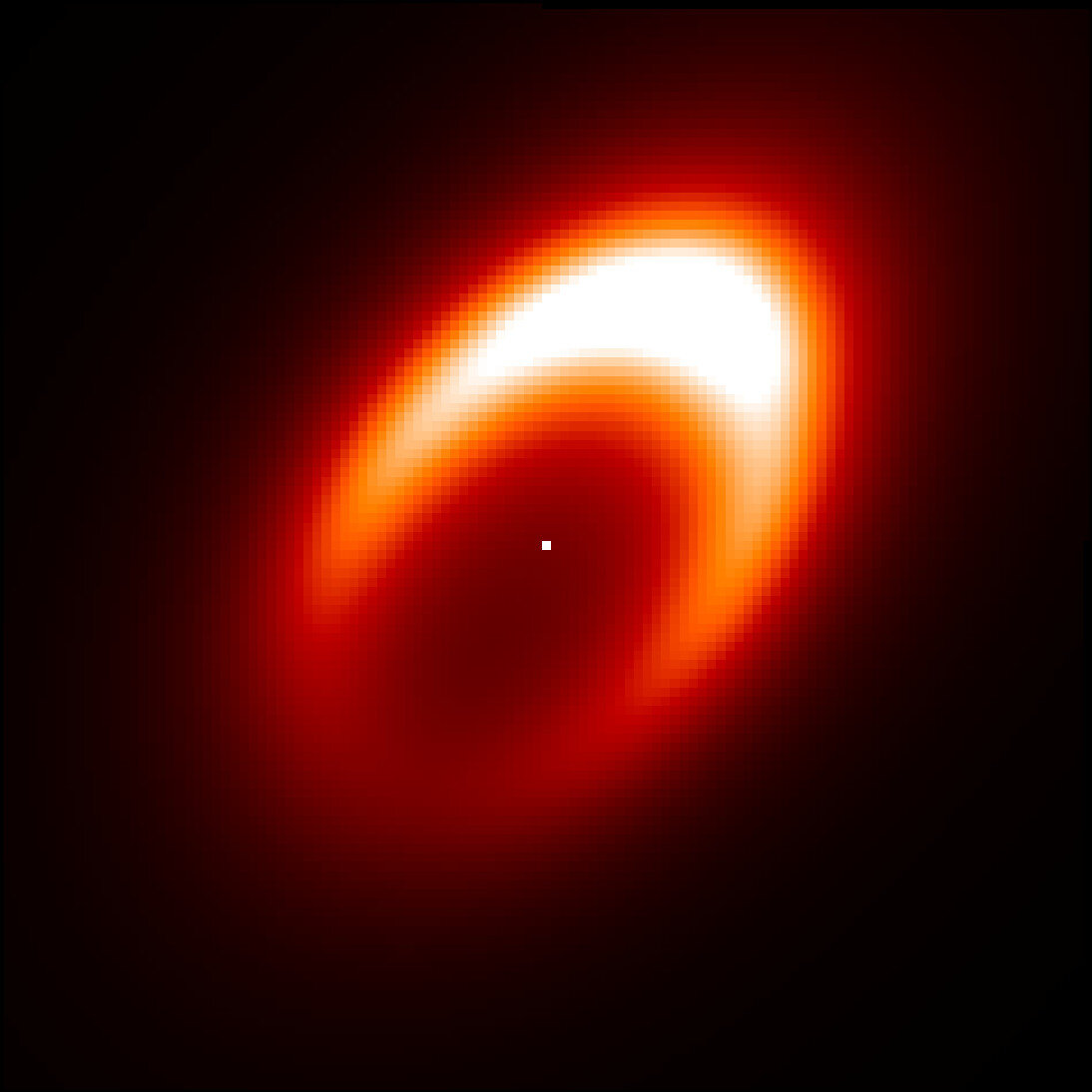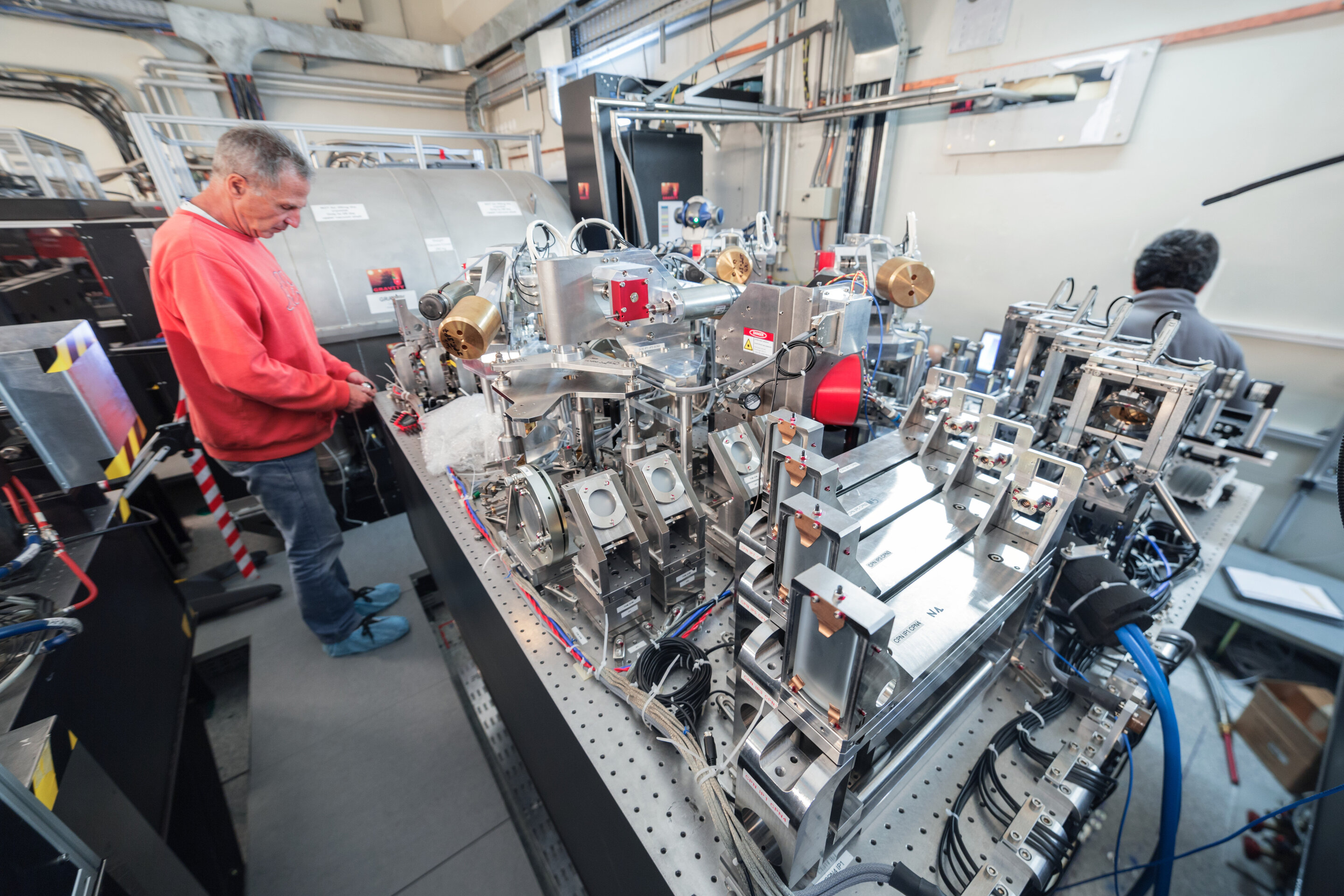From Netherlands Research School for Astronomy [Nederlandse Onderzoekschool Voor Astronomie] (NL)
via
January 21, 2021

A schematic view of the vortex around the possible exoplanet-in-the-making around the star HD 163296 . The bright yellow spot in the upper right indicates an area of warm dust and pebbles where a planet is likely to be formed. Credit: J. Varga et al.
An international team of astronomers led by researchers from the Netherlands has discovered a whirlwind of dust and debris in orbit around a young star. It is possible that a planet is forming within the debris. The scientists made the discovery during the time that designers and developers of an astronomical instrument get as a reward for their work. They will soon publish their findings in the journal Astronomy & Astrophysics.
The exoplanet in the making orbits the star HD 163296 in a close orbit. HD 163296, about 330 light-years away from Earth, is a young star much studied by astronomers in the constellation of Sagittarius. Previously, astronomers found evidence for the formation of three large exoplanets in a wide orbit around the star. Now, a fourth planet may be forming close to the star.
The researchers led by Jozsef Varga (Leiden University, the Netherlands) studied the star during four nights in March and June 2019. They focused their telescope on the inner part of the circumstellar disk. The astronomers observed a ring of warm, fine dust at a distance from the star comparable to Mercury’s orbit around our sun. What was striking was that one part of the ring was much brighter, i.e., hotter, than the rest of the ring. This hot spot seemed to have an orbital period of about one month.
The astronomers suspect that the hot spot of warm, fine dust is a vortex in the disk from which a planet could form. Simulations could verify their suspicion. While in the rest of the disk, dust and pebbles clump together, in the vortex, the debris is actually ground into fine dust. That fine dust is visible in the hot spot.

The MATISSE instrument is located on the Very Large Telescope Interferometer (VLTI) at the ESO Observatory at Paranal, in northern Chile. Credit: ESO/P. Horálek
MATISSE
The researchers made their discovery with the new MATISSE instrument. That instrument combines and analyzes light from four telescopes of the ESO Observatory’s Very Large Telescope on Cerro Paranal, in northern Chile.

•KUEYEN (UT2; The Moon ),
•MELIPAL (UT3; The Southern Cross ), and
•YEPUN (UT4; Venus – as evening star).
elevation 2,635 m (8,645 ft) from above Credit J.L. Dauvergne & G. Hüdepohl atacama photo.
This creates a combined telescope with a virtual diameter of 200 meters. The MATISSE instrument is made specifically to analyze infrared radiation. Such radiation is created when an object, such as a planet or dust disk, gives off heat. The instrument is cooled to prevent it from emitting infrared radiation itself.
The Netherlands Research School for Astronomy (NOVA) built all the lenses and mirrors in the cooled part of MATISSE together with Dutch industry. In 2018, MATISSE saw its first light with a series of test observations.
For the researchers and engineers from, amongst others, Leiden University, University of Amsterdam, Radboud University Nijmegen, SRON and the NOVA Optical Infrared Group, this first, real scientific result marks the beginning of further research. One of the goals is to study more stars with dust disks and especially dust disks in which earthlike planets can form.
See the full article here.
five-ways-keep-your-child-safe-school-shootings
Please help promote STEM in your local schools.
NOVA stands for ‘Nederlandse Onderzoekschool Voor Astronomie’, i.e., the ‘Netherlands Research School for Astronomy’. It is the alliance of the astronomical institutes of the universities of Amsterdam, Groningen, Leiden, and Nijmegen. Astronomy is considered to be top-science in The Netherlands. NOVA was selected as top-research school in 1998 following an open national competition, and is as such receiving substantial funding by the Dutch Ministry of Education.
NOVA’s mission is to carry out frontline astronomical research in the Netherlands, to train young ast ronomers at the highest international levels, and to share our new discoveries with society.
NOVA: collaboration
The astronomical institutes at the universities of Amsterdam, Groningen, Leiden and Nijmegen together form NOVA. NOVA closely collaborates with the two other research institutes that are active in the field of astronomy in the Netherlands: The space research institute SRON and the radio astronomy institute ASTRON.
Collaboration and coordination of all partners in Dutch astronomy takes place within the Astronomy Council (RvdA) and the creation of decadal strategic plans and midterm updates by the RvdA.
NOVA astronomers rely heavily on the world-class facilities of the European Southern Observatory (ESO), most notably the VLT telescopes and the ALMA array.

•KUEYEN (UT2; The Moon ),
•MELIPAL (UT3; The Southern Cross ), and
•YEPUN (UT4; Venus – as evening star).
elevation 2,635 m (8,645 ft) from above Credit J.L. Dauvergne & G. Hüdepohl atacama photo.

A large fraction of the instrument projects that NOVA participates in are targeted at these facilities, as well as the future Extremely Large Telescope.



